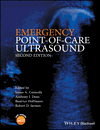Ultrasound in the Management of Fractures
Paul Atkinson
Search for more papers by this authorTyler Johnston
Search for more papers by this authorJoe Rigley
Search for more papers by this authorPaul Atkinson
Search for more papers by this authorTyler Johnston
Search for more papers by this authorJoe Rigley
Search for more papers by this authorJames A. Connolly
Search for more papers by this authorAnthony J. Dean
Search for more papers by this authorBeatrice Hoffmann
Search for more papers by this authorRobert D. Jarman
Search for more papers by this authorSummary
Point-of-care ultrasound (PoCUS) can provide an alternative to the traditional use of plain radiography and fluoroscopy in both the diagnosis and reduction of certain fractures. PoCUS also has potential in pregnant patients, and in children where ultrasound may surpass the sensitivity of radiography in poorly ossified bones. PoCUS guidance for forearm fracture reduction is a promising development, especially where there is a lack of real-time fluoroscopy or in reducing radiation dosages. The ability to check for fracture position prior to the application of a splint or cast can reduce the number of reduction attempts. Several studies have shown that ultrasound-guided forearm fracture reduction is very frequently successful on the first attempt, and that PoCUS determination of fracture position correlated well with radiography. Residency or fellowship training in PoCUS can be supplemented by specialised training courses or workshops for this and similar musculoskeletal ultrasound techniques.
Further Reading
- Ackermann, O., Liedgens, P., Eckert, K., et al. (2009) Ultrasound diagnosis of forearm fractures in children: a prospective multicenter study. Unfallchirurg., 112, 706–711.
- Atkinson, P., Iftikhar, K., Naveed, A., Kendall, R., van Rensburg, L., Madan, R. (2011) Ultrasound-guided paediatric forearm fracture reduction with sedation in the emergency department. Clin. J. Emerg. Med., 13, 173.
- Atkinson, P., Lennon, R. (2003) Use of emergency department ultrasound in the diagnosis and early management of femoral fractures. Emerg. Med. J., 20, 395.
- Beaudoin, F.L., Nagdev, A., Merchant, R.C., et al. (2010) Ultrasound-guided femoral nerve blocks in elderly patients with hip fractures. Am. J. Emerg. Med., 28, 76–81.
- Chaar-Alvarez, F.M., Warkentine, F.W., Cross, K.P., et al. (2009) Bedside ultrasound diagnosis of non-angulated forearm fractures in the pediatric emergency department, in American Academy of Pediatrics National Conference and Exhibition. Washington, DC, Section on Emergency Medicine.
- Chen, L., Kim, Y., Moore, C.L. (2007) Diagnosis and guided reduction of forearm fractures in children using bedside ultrasound. Pediatr. Emerg. Care, 23, 528–531.
- Chien, M., Bulloch, B., Youssfi, M., et al. (2010) Diagnosis of pediatric clavicle fractures [Abstract], in Pediatric Academic Societies, Vancouver, BC.
- Chinnock, B., Khaletskiy, A., Kuo, K., et al. (2009) Ultrasound-guided reduction of distal radius fractures. J. Emerg. Med., E-published.
- Cho, K.H., Lee, S.M., Lee, Y.H., et al. (2010) Ultrasound diagnosis of either an occult or missed fracture of an extremity in pediatric-aged children. Korean J. Radiol., 15, 84–94.
- Cross, K.P., Padmanabhan, P., Stevenson, M.D. (2010) Ultrasound-guided femoral nerve blocks in the pediatric emergency department [Abstract], in Pediatric Academic Societies, Vancouver, BC.
- Cross, K.P., Warkentine, F.W., Kim, I.K., et al. (2010) Bedside ultrasound diagnosis of clavicle fractures in the pediatric emergency department. Acad. Emerg. Med., 17, 687–693.
- Durston, W., Swartzentruber, R. (2000) Ultrasound-guided reduction of pediatric forearm fractures in the ED. Am. J. Emerg. Med., 18, 72–77.
- Eksioglu, F., Altinok, D., Uslu, M.M., et al. (2003) Ultrasonographic findings in pediatric fractures. Turk. J. Pediatr., 45, 136–140.
- Fisher, N.A., Newman, B., Lloyd, J., et al. (1995) Ultrasonographic evaluation of birth injury to the shoulder. J. Perinatol., 15, 398–400.
- Graif, M., Stahl-Kent, V., Ben-Ami, T., et al. (1988) Sonographic detection of occult bone fractures. Pediatr. Radiol., 18, 383–385.
- Heiner, J.D., McArthur, T.J. (2009) A simulation model for the ultrasound diagnosis of long-bone fractures. Simul. Healthcare, 4, 228–231.
- Hubner, U., Schlicht, W., Outzen, S., et al. (2000) Ultrasound in the diagnosis of fractures in children. J. Bone Joint Surg. Br., 82, 1170–1173.
- Hunter, J.D., Mann, C.J., Hughes, P.M. (1998) Fibular fracture: detection with high resolution diagnostic ultrasound. J. Accident. Emerg. Med., 15, 118.
- Jones, G.P., Seguin, J., Shiels, W.E., et al. (2003) Fracture of the proximal humerus in a preterm infant. Am. J. Perinatol., 20, 249–253.
- Katz, R., Landman, J., Dulitzky, F., et al. (1988) Fracture of the clavicle in the newborn. An ultrasound diagnosis. J. Ultrasound Med., 7, 21–23.
- Lewis, D., Logan, P. (2006) Sonographic diagnosis of toddler's fracture in the emergency department. J. Clin. Ultrasound, 34, 190–194.
- Lyon, M., Blaivas, M. (2003) Evaluation of extremity trauma with sonography. J. Ultrasound Med., 22, 625–630.
- Ma, O.J., Norvell, J.G., Subramanian, S. (2007) Ultrasound applications in mass casualties and extreme environments. Crit. Care Med., 35 (5 Suppl.), S275–S279.
- Marshburn, T.H., Legome, E., Sargsyan, A., et al. (2004) Goal-directed ultrasound in the detection of long-bone fractures. J. Trauma, 57, 329–332.
- McNeil, C.R., McManus, J., Mehta, S. (2009) The accuracy of portable ultrasonography to diagnose fractures in an austere environment. Prehosp. Emerg. Care, 13, 50–52.
- Melniker, L.A., Leibner, E., McKenney, M.G., et al. (2006) Randomized controlled clinical trial of point-of-care, limited ultrasonography for trauma in the emergency department: the first sonography outcomes assessment program trial. Ann. Emerg. Med., 48, 227–235.
- Moritz, J.D., Berthold, L.D., Soenksen, S.F., et al. (2008) Ultrasound in diagnosis of fractures in children: unnecessary harassment or useful addition to x-ray? Ultraschall. Med., 29, 267–274.
- Noble, V.E., Legome, E., Marshburn, T. (2003) Long bone ultrasound: making the diagnosis in remote locations. J. Trauma, 54, 800.
- Patel, D.D., Blumberg, S.M., Crain, E.F. (2009) The utility of bedside ultrasonography in identifying fractures and guiding fracture reduction in children. Pediatr. Emerg. Care, 25, 221–225.
- Pistor, G., Graffstadt, H. (2003) Sonographic diagnosis of supracondylar fractures of the humerus. Ultraschall. Med., 24, 331–339.
- Spencer, J.K., Adler, R.S. (2008) Utility of portable ultrasound in a community in Ghana. J. Ultrasound Med., 27, 1735–1743.



